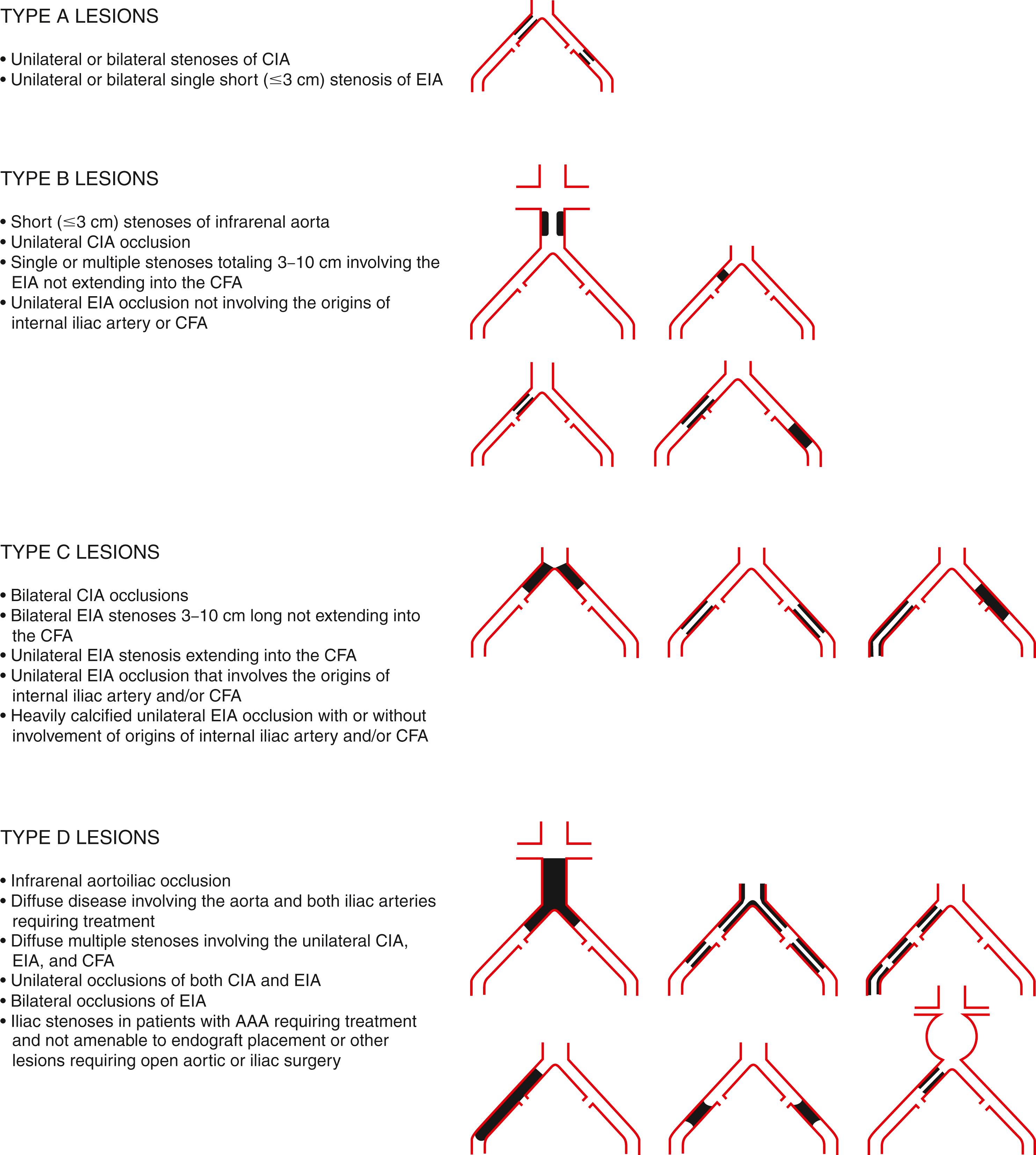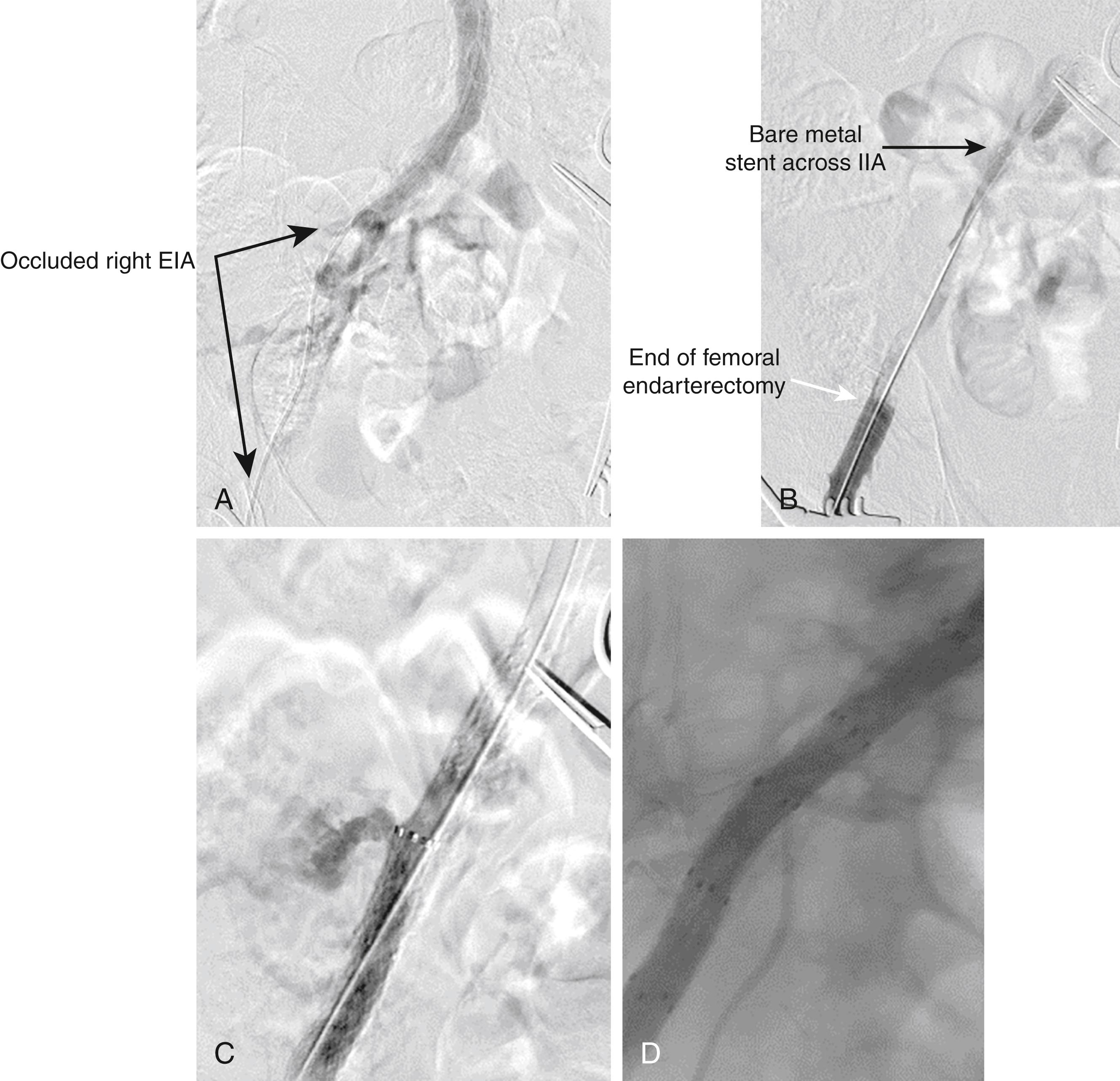Physical Address
304 North Cardinal St.
Dorchester Center, MA 02124
Progress in endovascular surgery has resulted in a continued shift in the treatment of patients with aortoiliac occlusive disease to less invasive forms of therapy. Early pioneers such as Dotter and Gruntzig developed balloon angioplasty. Subsequent work in stent development by Palmaz gradually improved the treatment of patients with aortoiliac disease. Improvements in technology such as higher resolution imaging, lower profile systems, premounted balloon-expandable stents, self-expanding stents, and stent grafts have resulted in better outcomes and lower complications. Vascular surgeons now incorporate these treatment modalities into much of their practice. Today the majority of patients with aortoiliac occlusive disease can be safely treated with either percutaneous endovascular procedures or, in patients with more advanced aortoiliac occlusive disease, by means of stent grafts and hybrid open endovascular approaches.
There are both patient- and lesion-specific indications for aortoiliac intervention. Patient-specific indications for treatment include lifestyle-limiting claudication, rest pain, and tissue loss. Less frequent indications include vasculogenic impotence and atheroembolization to the lower extremities. As for all vascular reconstructions, the expected benefits of the proposed procedure must be weighed against the potential risks in view of patient comorbidities.
Patients with hip, buttock, thigh, or calf claudication constitute the largest group of patients who undergo aortoiliac endovascular revascularization. Patients with critical limb ischemia (CLI) manifesting as either rest pain or tissue loss frequently have multilevel occlusive disease. In this patient population, the aortoiliac disease is commonly diffuse and complex, often extending into the common femoral arteries (CFAs) and associated with infrainguinal occlusive disease. Patients in whom CFA occlusive disease does not cause significant obstruction can typically be treated with percutaneous approaches that improve perfusion to the lower extremities sufficiently to resolve the rest pain or heal ischemic ulceration. In patients with a significant CFA disease burden, combined femoral artery endarterectomy and patch angioplasty with simultaneous aortoiliac stenting or stent grafting often provides adequate perfusion to treat CLI and claudication.
Patients younger than 50 years have worse outcomes following aortoiliac endovascular therapy. However, the same is generally true for open surgical approaches such as aortobifemoral bypass. Many younger patients cannot be absent from work for the 6- to 8-week recovery period required after open aortic surgery, and as a result they may opt for the less invasive endovascular approach acknowledging a potentially less durable outcome when compared to open surgical reconstruction. In addition, many men are concerned about the relatively high incidence of erectile dysfunction that can occur following open aortobifemoral bypass surgery and thus choose an endovascular approach.
Less frequently encountered are patients who present with spontaneous embolization to the lower extremity, or so-called blue toe syndrome, who may benefit from endovascular therapy. This is a controversial indication for endovascular therapy and usually involves placement of a bare or covered stent to trap the underlying pathogenic atherosclerotic lesion and prevent further embolization. Endovascular intervention is typically not indicated for patients whose atheroembolization is a result of arterial catheterization procedures. In the absence of subsequent catheterization procedures, the risk of recurrent embolization is low.
Endovascular therapy for aortoiliac disease is frequently required as an adjunct to various open infrainguinal procedures to provide adequate inflow. It may be performed simultaneously with lower extremity bypass or in conjunction with femoro-femoral bypass. Indications for treatment in this setting include a resting systolic pressure gradient proximal to the intended infrainguinal bypass procedure of greater than 10 mm Hg or a vasodilator-enhanced systolic gradient of greater than 20 mm Hg.
There are no absolute contraindications to the endovascular treatment of aortoiliac occlusive disease. Relative contraindications are largely anatomic and include juxtarenal aortic occlusion, circumferential heavy (>1 mm) calcification, hypoplastic aortic syndrome, and juxtaposition to aneurysmal disease. Renal insufficiency is also a relative contraindication owing to potential contrast-induced nephropathy, although preventive regimens and minimal contrast techniques have reduced the impact of this complication.
Lesion-specific indications for the endovascular therapy of aortoiliac occlusive disease can be guided by the Trans-Atlantic Inter-Society Consensus (TASC) guidelines. The TASC classification system ( Fig. 111.1 ) was revised in 2007 to offer more current guidelines on the use of endovascular therapy based on lesion anatomy. In general, endovascular therapy is the recommended first-line therapy for TASC A and B lesions and increasingly for TASC C lesions as endovascular techniques improve. Good-risk patients with TASC type C disease can also be treated with open surgery, depending on patient preference. Surgery is usually recommended for TASC D lesions, but advanced endovascular approaches are now being applied in these lesions as well, with good results. High-risk patients with TASC C and D disease, CLI, and advanced comorbidities such as severe chronic obstructive pulmonary disease, unreconstructable coronary artery disease, or a low cardiac ejection fraction may be treated with endovascular therapy, acknowledging that this approach will be less durable than open surgical options.

Once a decision has been made that intervention is indicated (see Ch. 108 , Lower Extremity Arterial Disease: Decision Making and Medical Treatment), information must be gathered to determine the location and extent of the atherosclerotic occlusive disease. This begins with a history and physical examination to determine whether the aortoiliac segment is involved. A history of hip, thigh, or buttock claudication; impotence; the presence of a lower quadrant abdominal or CFA bruit; and diminished femoral pulses are all suggestive of aortoiliac occlusive disease. Patients should undergo noninvasive physiologic arterial studies, such as ankle–brachial index (ABI) and toe pressure measurements, if indicated. In patients with a history suggestive of vasculogenic claudication but a normal pulse exam or resting ABI, treadmill testing may help differentiate vascular from neurogenic symptoms.
Just as when planning for an open aortobifemoral bypass, additional diagnostic studies are indicated before endovascular intervention to assess the location and extent of arterial occlusive disease and the degree of calcification. The use of arteriography as a purely diagnostic tool is infrequently indicated because of the widespread availability of less invasive imaging modalities that provide anatomic detail without the risks of an invasive procedure. A decision to proceed with endovascular treatment versus open revascularization can be made without the use of arteriography. Imaging modalities currently used to evaluate the aortoiliac segment include duplex arterial mapping, magnetic resonance angiography (MRA), and computed tomographic angiography (CTA). All these modalities have benefits and drawbacks.
Duplex arterial mapping of the aortoiliac segment and CFAs can adequately assess the location of hemodynamically significant lesions ( Fig. 111.2 ). It is particularly helpful to assess the burden of disease in the CFA which may potentially alter a planned percutaneous approach through the CFA to an open CFA endarterectomy and concomitant iliac stent/stent graft placement. This modality is especially useful in patients with renal insufficiency who are at risk for contrast-induced renal dysfunction. Drawbacks of duplex arterial mapping are that it provides only a semiquantitative assessment of the degree of iliac calcification, it may not adequately image the iliac system in certain patients owing to overlying bowel gas or body habitus, and it requires a significant time commitment and a highly trained vascular technologist. , These constraints have prevented duplex arterial mapping from becoming a more widely adopted imaging modality.

MRA can reliably assess the aortoiliac arterial segment, although there is institutional variability in its accuracy. The major drawback to MRA is its failure to provide an accurate assessment of the degree of calcification of aortoiliac lesions. It remains contraindicated in patients with renal insufficiency over concerns regarding increased risk of nephrogenic systemic fibrosis due to gadolinium.
The presence of severe calcification has significant implications for operative or interventional planning. Circumferential calcification thicker than 1 mm is a relative contraindication to aortoiliac angioplasty and stenting because of the potential risk of fracture and rupture of the artery. In patients with significant comorbidities in whom intervention is mandated by CLI, use of a stent graft may be considered in an attempt to limit the incidence of clinically significant arterial perforation. In this setting, CTA has been used with success to assess calcification of the aortoiliac segment before intervention. The major disadvantages of this imaging modality include exposure to ionizing radiation and the need for iodinated contrast agent, with the risk of contrast-induced renal dysfunction. In appropriate patients, CTA can accurately assess lesion location and extent and degree of calcification. Based on CTA, the severity of aortoiliac and femoral disease can be classified according to TASC; this additional information regarding anatomy and severity of calcification allows the formulation of an appropriate procedural plan and the selection of either open or endovascular therapy.
The determination whether to proceed with percutaneous endovascular therapy or an open femoral approach is based on the presence of significant CFA disease. Patients with greater than 50% CFA stenosis on duplex arterial mapping, MRA, or CTA are usually treated with a hybrid approach that entails open ileo-femoral endarterectomy, patch angioplasty, and simultaneous stent or stent-graft placement. In general stent grafts are frequently used in conjunction with open endarterectomy especially in the presence of calcific external iliac artery disease due to the risk of arterial rupture and bleeding with bare metal stents ( Fig. 111.3 ). In patients with less severe CFA disease, a percutaneous approach can be undertaken.

Aortic angioplasty and stenting for lesions proximal to the aortic bifurcation warrant special consideration because these lesions are frequently exophytic and calcific. When treating such lesions, emphasis should be placed on obtaining an adequate hemodynamic response; acceptance of an imperfect angiographic completion image is critical to avoid aortic rupture. Because of the exophytic nature of these lesions, primary stent or stent-graft placement to trap potential atheroembolic debris should be considered. Primary stenting or stent grafting should also be considered for lesions suspected of being the source of atheroembolization to minimize the potential for embolic complications.
Before the intervention, the patient’s history and all pertinent imaging studies are reviewed, and informed consent is obtained. Patients’ medications typically include an antiplatelet agent and a statin. Recent data from the COMPASS and VOYAGER trials suggests that patients not on dual antiplatelet therapy should be treated with an antiplatelet agent such as 81 mg aspirin per day and low dose rivaroxaban 2.5 mg BID. Patients treated with aspirin and low dose rivaroxaban had significantly lower long-term major cardiovascular events and lower acute limb events compared to aspirin alone. , Laboratory tests of coagulation status and renal function are essential.
Become a Clinical Tree membership for Full access and enjoy Unlimited articles
If you are a member. Log in here